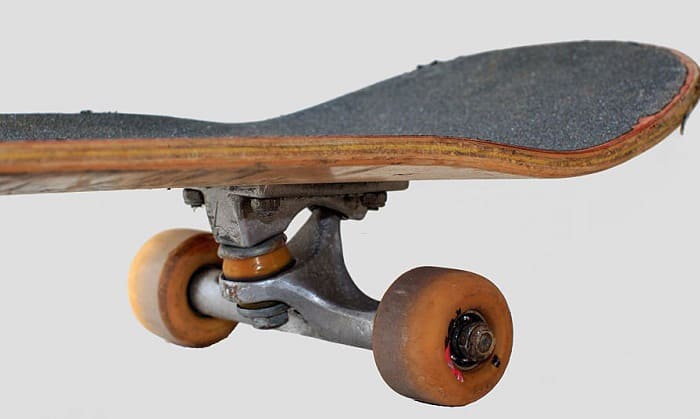When checking a skateboard’s dimensions, we always see its width being the most significant part. Essentially, the deck’s width indicates how much stepping surface we have, which also relates to our stability.
But have you ever paid attention to skateboard thickness? If not, it’s about time you learn about it. So, how thick is a skateboard? Often, it goes around less than half an inch. However, several factors could change it.
In this article, we’ll discuss these aspects and see what deck suits us best.
Table of Contents
How Thick Should a Skateboard Be?
Is 10mm to inches equal to a deck’s thickness? Pretty much, yes, since 10 mm is around 0.4 inch.
With that question answered, we’ll use inches and not sizes in cm or mm for a straightforward discussion on board thickness.
An average deck of a skateboard has dimensions of 32″ in length, 8″ in width, and a thickness of almost 0.5″. But as mentioned, the final figure can change based on the materials used to make the deck. Let’s get into them.
1. Canadian maple
Most manufacturing companies top the skateboard markets because of the Canadian maple wood on their decks. This material is famous for its durability and pop during rides.
A maple veneer has a thickness of 1/16 of an inch and comes in variants called the Face, Core, and Cross Grain. Skateboard makers glue three Core layers with other veneers alternately, giving the maple skateboard an overall thickness of 7/16″.
2. Plywood
Perhaps, only a few stores today sell plywood skateboards because of the emergence of other durable and sustainable materials. Nonetheless, Baltic Birch Plywood used to be the most popular plywood type for making skateboards.
Each layer of Baltic Birch has two 1/32″ sections of Face plywood and a 1/16″ Crossband at the center, yielding a 1/8″ thickness. Brands that use this type of wood glue four layers of this setup together, making the skateboard 1/2″ thick.
3. Bamboo
Like plywood, bamboo has less popularity than maple, but a skateboard made with this material is very springy.
Skateboard manufacturers have no fixed number of bamboo veneers used when making skateboards, but each layer has a 1/16″ thickness. One of the configurations many brands create with this material is incorporating it with maple and fiberglass.
When working with maple and bamboo, skateboarders use three bamboo veneers as the middle and external layers, while four maple layers (Core and Cross Grain) make up the rest. All in all, the bottom of a skateboard to its top will get a 7/16″ thickness.
Frequently Asked Questions
How many layers of wood are in a skateboard?
Different trees are in the average skateboard. If you check out famous skateboard brands on Amazon or any physical store near you, most boards will have 7-9 layers of wood.
These layers might vary, depending on the brand and type of wood, but that’s an average figure.
How big is a real skateboard?
With boards fitting any rider’s size, age, and style, it’s reasonable to see variations in skateboards dimensions and deck shapes.
Real skateboards have a length of 28″ to 33″ and a width of 7.5″ to 9.0″. Since lengths don’t influence performance that much, let’s understand widths better by knowing what different sizes are suitable for.
You can also check out skateboard diagrams from brands, which can serve as guides for selecting the right deck.
- 8.0″ to 8.25″ – Street skating and heavy skaters
- At least 8.25″ – Skate parks
- 8.5″ to 9″ – Bowls and vert
Conclusion
Skateboard decks are worthy of attention because they house the parts of a skateboard, like the skateboard truck and grip tape. Thus, choosing the perfect deck size should be more of a responsibility than a luxury.
And like the length and width, knowing about the skateboard’s thickness can also put us ahead when buying gear. So, how thick is a skateboard? It’s more or less 0.5″, depending on various materials.
Remember the numbers and material properties we discussed as well. It’ll help you decide on the best skateboard deck in the long run.

Hi, I am Charles Harris. I opened this site to write as much as I can about my biggest passion – skateboarding!
I started as a clumsy yet passionate rookie 10 years ago to now a still passionate yet much better skateboarder! But I have to tell you, the whole journey has always been fun and rewarding, indeed not without hardship.




